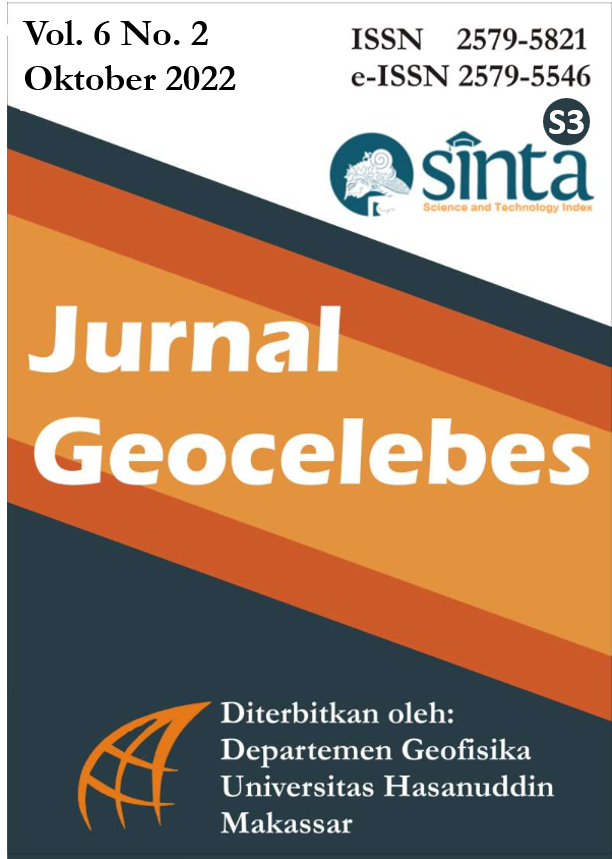Subsurface Profile Analysis for Aquifer Layer Identification
Analisis Profil Bawah Permukaan untuk Identifikasi Lapisan Pembawa Air
DOI:
https://doi.org/10.20956/geocelebes.v6i2.21911Keywords:
aquifers, geoelectric, tuff, volcanic breccia, WennerAbstract
Bungaiya village is a village located in Gowa Regency which has volcanic rock lithology with one of the problems faced in volcanic rocks is that the rock porosity is small so that this layer cannot be an aquifer zone. But the water needs needed by the community for agriculture are very large. Geoelectric is a geophysical method that can be used to describe subsurface profiles, especially aquifer layers. The purpose of this study is to interpret using the geoelectric resistivity method, is the Wenner configuration method as many as 2 lines with a length of 470 m and a space of 10 m. The interpretation results on Line 1, there are 3 layers, are volcanic breccia with resistivity values of 85.6 – 2.2013.19 Ωm and depths between 1.2 – 68 m, layer 2 of tuff with resistivity values of 9.82 – 59.68 Ωm, depth of 12 – 76 m and the third layer is a volcanic breccia, resistivity value is 85.6 – 176 Ωm. Line 2 has 2 layers, are the first layer with a depth of 1.2 – 42 m with a resistivity value of 93 – 490.41 Ωm which is a volcanic breccia. The second layer at a depth of 1.2 – 78.8 m with a resistivity value of 30.9 – 77, 67 Ωm is tuff. Layers 1 and 2 show a similar subsurface profile. Based on these results, it can be concluded that the layer that functions as a water-carrying layer is tuff with a resistivity value of 9.82 – 77.67 Ωm.Downloads
References
Afasedanja, M.T. 2020. Hubungan Morfologi dengan Mekanika Properties (Batuan Vulkanik) terhadap Kestabilan Lereng pada Daerah Aliran Sungai Jeneberang Provinsi Sulawesi Selatan. Jurnal Teknik AMATA. 1(1), pp.5 – 10. https://ojs.pat.ac.id/index.php/Amata_amamapare/article/view/20
Asmaranto, R. 2012. Identifikasi Air Tanah (Groundwater) Menggunakan Metode Resistivity (Geolistrik with IP2WIN Software). Malang: Universitas Brawijaya.
Bundang, S., Azikin, B. dan Sultan. 2020. Korelasi Data Geolistrik dan Electrical Logging untuk Analisis Ketebalan Lapisan Batuan Piroklastik di Desa Watang Pulu, Kecamatan Suppa, Kabupaten Pinrang. Jurnal Geocelebes. 4(2), pp.134-143. https://doi.org/10.20956/geocelebes.v4i2.11324
Dobrin, B.M. and Savit, C.H. 1988. Introduction to Geophysical Prospecting, 4th ed. New York: McGraw Hill Bool Company.
Hendrayana, H. dan Putra, D.P.E. 2008. Konservasi Air Tanah. Yogyakarta: Universitas Gajah Mada.
Husain, J.R. dan Sultan. 2012. Analisis Cutting Bor dan Nilai Resistivity Batuan untuk Penentuan Letak Pipa Saringan Pada Sumur Bor di Daerah Kampus Unhas Tamalanrea Kota Makassar. In: Prosiding Hasil Penelitian Fakultas Teknik vol 6.
Loke, M.H. 2001. Tutorial: 2-D and 3-D Electrical Imaging Surveys. http://www.geotomosoft.com/downloads.php
Massinai, M.A., Bundang, S., Massinai, M.F.I. dan Hidayat, W. 2019. Tipologi Sistem Akuifer Gunungapi. Jurnal Geomine. 7(2), pp.124 – 132. https://doi.org/10.33536/jg.v7i2.346
Mohammad, F., Mardiana, U., Yuniardi, Y., Firmansyah, Y. dan Alfadli, K. 2016. Potensi Air Tanah Berdasarkan Nilai Resistivitas Batuan di Kelurahan Cangkorah, Kecamatan Batujajar, Kabupaten Bandung Barat. Bulletin of Scientific Contribution. 14(2), pp.141-152. http://jurnal.unpad.ac.id/bsc/article/view/9799
Nurdin, N.H., Massinai, M.A. dan Aswad, S. 2017. Identifikasi Pola Sebaran Intrusi Batuan Bawah Permukaan Menggunakan Metode Geomagnet di Sungai Jenelata Kabupaten Gowa. Jurnal Geocelebes. 1(1), pp.17 – 22. https://doi.org/10.20956/geocelebes.v1i1.1776
Purnama, A. dan Noval, A. 2017. Kajian Potensi Air Tanah dengan Pengujian Geolistrik di Desa Telonang Kabupaten Sumbawa Barat. Jurnal SAINTEK UNSA. 2(1), pp.1 – 14. https://osf.io/preprints/inarxiv/654n9/
Sedana, D., As’ari. dan Tanauma, A. 2015. Pemetaan Akuifer Air tanah di Jalan Ringroad, Kelurahan Malendeng dengan Menggunakan Metode Geolistrik Tahanan Jenis. Jurnal Ilmiah Sains.15(2), pp.33 – 37. https://doi.org/10.35799/jis.15.1.2015.6778
Sukamto, R. dan Suriatna, S. 1982. Peta Geologi Lembar Ujung Pandang, Benteng dan Sinjai, Sulawesi. Bandung: Pusat Penelitian dan Pengembangan Geologi Direktorat Jenderal Pertambangan Umum Departemen Pertambangan dan Energi. https://geologi.esdm.go.id/geomap/pages/preview/peta-geologi-lembar-buton-sulawesi-tenggara
Telford, W.M., Geldart, L.P. and Sheriff, R.E. 1990. Applied Geophysics 2nd ed. Cambridge: Cambridge University Press.
Winarti. 2013. Metode Geolistrik untuk Mendeteksi Akuifer Air Tanah di Daerah Sulit Air (Studi Kasus di Kecamatan Takeran, Pancol dan Parang, Kabupaten Magetan. Jurnal Angkasa. 5(1), pp.83 – 94. https://repository.itny.ac.id/id/eprint/3267/1/METODE_GEOLISTRIK_UNTUK_MENDETEKSI_AKUIFER_AIRTANA.pdf
Yuwono, Y.S. 1990. Produk Volkanik Pare-pare (Sulawesi Selatan). di: PIT XIX IAGI, 11-13 Desember 1990, Bandung: Proc.PIT IAGI.
Downloads
Published
How to Cite
Issue
Section
License
Authors who publish with this journal agree to the following terms:
- Authors retain copyright and grant the journal right of first publication with the work simultaneously licensed under a Creative Commons Attribution License that allows others to share the work with an acknowledgement of the work's authorship and initial publication in this journal.
- Authors are able to enter into separate, additional contractual arrangements for the non-exclusive distribution of the journal's published version of the work (e.g., post it to an institutional repository or publish it in a book), with an acknowledgement of its initial publication in this journal.
- Authors are permitted and encouraged to post their work online (e.g., in institutional repositories or on their website) prior to and during the submission process, as it can lead to productive exchanges, as well as earlier and greater citation of published work (See The Effect of Open Access).



